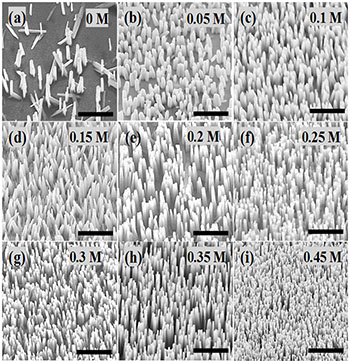
SEM images of nanowires grown under ammonium hydroxide concentrations of 0, 0.05, 0.1, 0.15, 0.2, 0.25, 0.3, 0.35 and 0.45 M, respectively. Credit: M.R. Alenezi et al. Sci. Rep. 5, 8516 (2015).
Researchers from the U.K. and Kuwait have created a hydrothermal technique to make on-chip ultraviolet (UV) detectors out of zinc oxide nanowires that are 10,000 times more sensitive than their traditional flat-film counterparts (Sci. Rep., doi: 10.1038/srep08516). UV detectors can help prevent sun overexposure and can sense radiation from fires; therefore, they must be fast and sensitive to be effective. The authors say that in addition to greatly improving detector response time and sensitivity, their flexible nanowire arrays can also fit into many different environments and are relatively low-cost compared to film detectors.
The research team, led by Ravi Silva at the University of Surrey, U.K., grew zinc oxide nanowires by applying a solution of zinc nitrate, HMTA and ammonium hydroxide to a gold-patterned silicon substrate chip at 90 °C for 3 hours. They were able to control nanowire morphology by varying the concentration of ammonium hydroxide in the solution. And, with scanning electron microscopy (SEM), they verified that nanowire growth was site-selective—only appearing on the gold-covered areas of the chip.
The resulting on-chip UV detector looks like a brush—zinc oxide nanowire “bristles” sprout directly from the gold-coated areas on the silicon chip. The bristle design increases the detector’s surface area, which results in increased sensitivity (105) and nanowatt detectability compared with typical devices. Faster reaction and recovery speeds (90 ms and 210 ms, respectively) are attributed to the unique nanowire-nanowire junction and the direct contact between the nanowires and gold electrode coating. (Nanowire arrays are often grown from a seed layer, which physically separates them from the electrodes).
The authors believe their technique can be adapted to create on-chip devices made from other metal oxides and that the site-selective growth could be particularly useful for gas sensor, piezoelectronic and solar cell applications.
